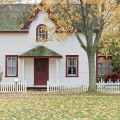Not surprisingly, cost is one of the main drivers of the trend toward smaller homes. Smaller homes mean smaller mortgages, lower development costs and reduced expenses. Smaller homes mean smaller mortgages, lower development costs, and lower spending on administration and maintenance. Smaller spaces also mean lower costs overall, from utilities, taxes, raw materials and maintenance to furniture and other interior decoration items.
Having a smaller home means less time to clean and maintain it, and more time to do the things you love. Many homebuyers, especially those of the millennial generation, are opting for smaller homes to have free time for things like traveling and spending time with friends and family. Living in smaller homes and reducing the size of possessions also offers more freedom to move if the desire arises. Packing a smaller home is easier and less expensive if you ever decide that you're ready for a change of scenery or that you accept the next big career change.
Whether downsizing is a trend you love, or you just can't understand it, it's here to stay for now. From financial benefits to environmental bonuses and financial aid, smaller homes are a clear solution for many of the millennials and baby boomers looking to free up some money and time. I totally agree with you on this. There's no doubt that tiny homes are making a comeback as people realize how cozy and cheap they can be.
Smaller homes just feel good, and living in one makes it easier to be close to your family. Plus, the cost savings of smaller homes can add up over the long term. Therefore, many millennials are looking not only for smaller homes but also for homes that are more energy efficient and healthier. They are moving out of cities, which are too expensive, and are looking for smaller homes that require less maintenance and lower heating and cooling costs.
Homes are less expensive to buy and operate and offer the opportunity to enjoy more leisure activities. To understand this trend, we must first look at the younger generations of shoppers, that is, Generation Z and the millennials. These age groups tend to have more urban, higher-density homes that provide greater access to services. Because of this, we have noticed an increase in planned communities with a lot of mixed uses.
The American obsession with big houses, a matter of culture, politics and economics, restricts smaller, more affordable options. The monthly rates and fees for the condominiums and townhomes they found were also prohibitively expensive. They recently moved to a rental apartment in Humboldt Park and decided to save money and take another look at the market a year from now and, if necessary, look for less expensive neighborhoods, such as Portage Park, on the northwest side of the city. That magical house that's just the right size, the right price, and the right neighborhood just didn't exist.
Arias and Aguila are not the only ones who are excluded from the housing market because homes are expensive and oversized, making it difficult for potential landlords, especially those buying for the first time, to buy properties. If the desire and expectation of vast personal space have always been there, the pattern of ever-larger homes took off in the booming post-war economy. Federal housing policy guaranteed mortgages (for white Americans) and subsidized the construction of larger suburbs and housing complexes. The completion of the interstate highway system and urban renewal connected suburban homes with offices in the center of the city, allowing buyers to live in large homes far from the center of cities and, at the same time, have an easy commute to work.
The problem is the belief that every homeowner should have a large house and a large private courtyard calcified during a period of rapid expansion, and relatively open and available land close to urban centers. Jenny Schuetz, a Metropolitan Policy Program fellow who writes about land use and housing policy, says that the post-war boom was only possible because large tracts of cheap land were available in places where it was easy to build. Materials were also less expensive than they are today, so builders focused on a lucrative, highly standardized product (think of the Levittown suburb or one-story Los Angeles bungalows). These were initial single-family units, perfect for vets and their growing families to buy with their mortgages subsidized by the GI Act.
Now, after decades of building homes based loosely on this model, there is no land left for the construction of affordable single-family homes anywhere near the center of cities. And the predominance of zoning rules that only allow the construction of independent single-family homes in vast swaths of urban areas in the United States, as demonstrated by a New York Times analysis, creates shortages in urban neighborhoods, helping to increase the price of land and housing in general. How risk-averse policies and builders prevent us from building smaller homes Many neighborhoods are in the midst of this type of transformation, and an older, denser housing stock is being transformed into larger single-family homes. And today's builders aren't creating the slightly denser and more affordable options that were once the hallmark of urban development.
Dan Parolek, architect and founding director of the Berkeley, California-based firm Opticos, coined the term “the medium is missing” to describe this situation. It is a reference to older and more vernacular styles of housing, such as brownstone houses in Brooklyn or three-story houses in Chicago, which, according to him, the construction industry no longer offers more, despite the demand for this type of product. According to a report by the Urban Land Institute, today's builders are building fewer and fewer homes in the smallest category. Homes under 1,400 square feet typically account for 16 percent of new construction in the U.S.
UU. During the same period, homes that measured 1,800 square feet or less represented only 22 percent of new construction, while traditionally they represented 40 percent of the market. Over the past two decades, homes of more than 2,400 square feet, which in the past represented approximately one-third of new homes, now account for half of the market. However, amid the expansion of the United States, the size of the house, recently there has been a backward shift. Parolek has seen the same slow change in consumer demand and believes that the forces at play will drive the industry to adopt new solutions to help couples like Arias and Aguila achieve their dreams of owning. Unfortunately, traditional construction practices in the U.S. Make it difficult to create in a way that helps buyers make that tradeoff.
According to Parolek, the system does not allow for small units or more efficient use of limited land. Existing planning regulations often limit builders to, for example, four units on a 50-by-100-foot lot. This means that builders will maximize the size and profitability of that lot to make the construction economy work, which will dissuade them from building more smaller units that they feel could offer affordable housing to prospective buyers. There are also fees, both in the form of impact rates and parking requirements, that conspire to prevent architects and builders from using space most efficiently, especially if the goal is to provide more, smaller and cheaper housing.
Peter Crowley, partner at LandDesign, says he is seeing greater demand for townhouses and townhouses, which create a more sense of neighborhood in urban developments and master-planned communities. LandDesign's recent projects, such as the 300-acre Viridian development in North Arlington, Texas, or Westford, a 92-acre mixed-use community in Apex, North Carolina, focus on what he calls “the right size homes,” which means building townhomes in a way that combines amenities and green space and helps reduce the cost of new homes in these developments. Even modest increases in density can lead to more people sharing nearby public spaces, increasing the possibilities for social interaction. He says that in this case, it is always good to define what “small” really means.
In this case, the decision to build small units ranging from 860 to 1460 square feet, substantially smaller than those offered by other builders on the market, means fewer problems and better access to services and transportation, and a more walkable lifestyle. It also responds to the demands of a growing segment of the market. Developments that downplay car ownership and increase density, especially by taking advantage of new zoning regulations, can make smaller, more affordable housing not only possible but also desirable. Schuetz agrees and hopes that, as the conversation about zoning evolves, with more cities following the example of places like Minneapolis and prioritizing density, our social perceptions about what an initial home looks like will also change.
Usually, if they have enough money to buy a home outright, they have a financial advisor, or they just make an informed decision based on what they're comfortable with. As long as my daughter and son-in-law move out, my house will be perfect for the three of us (my 23-year-old son is on the autism spectrum and could very well be with us for a long time, if not forever). It's difficult to homeschool in a small house without taking control of the kitchen and that ends up being a chronic disaster. It will be interesting to see where the trend of smaller homes and the housing market is going from now on.
However, houses much smaller than ours tend to be in more run-down neighborhoods where neighbors don't seem to be proud to own. I have been used to living in my parents' house, which is quite large, but I have a hard time paying the bills because it needs a lot of maintenance and my utility bills are too high to pay with these types of houses. The current wave of television hits such as “Tiny House”, “Big Living”, “Tiny House Nation” and “Tidying Up with Marie Kondo” is a reflection of the growing momentum of minimalism. And the lender works in a very specific way to know that the buyer CAN afford the house and thus reduce their own losses.
The growing interest in tiny homes and accessory housing units (ADUs) is largely due to the high cost of housing and the challenges of first-time homebuyers in finding affordable housing. Approximately 18 states have already passed bills to allow ADUs in at least some parts of their states. My best childhood memories are being in my grandmother's house, with 4 bedrooms and 3 bathrooms, with aunts, uncles and cousins who visited me from all over the region. I'm looking forward to buying a smaller home of less than 2,000 square feet with more land to enjoy being outdoors.
.



